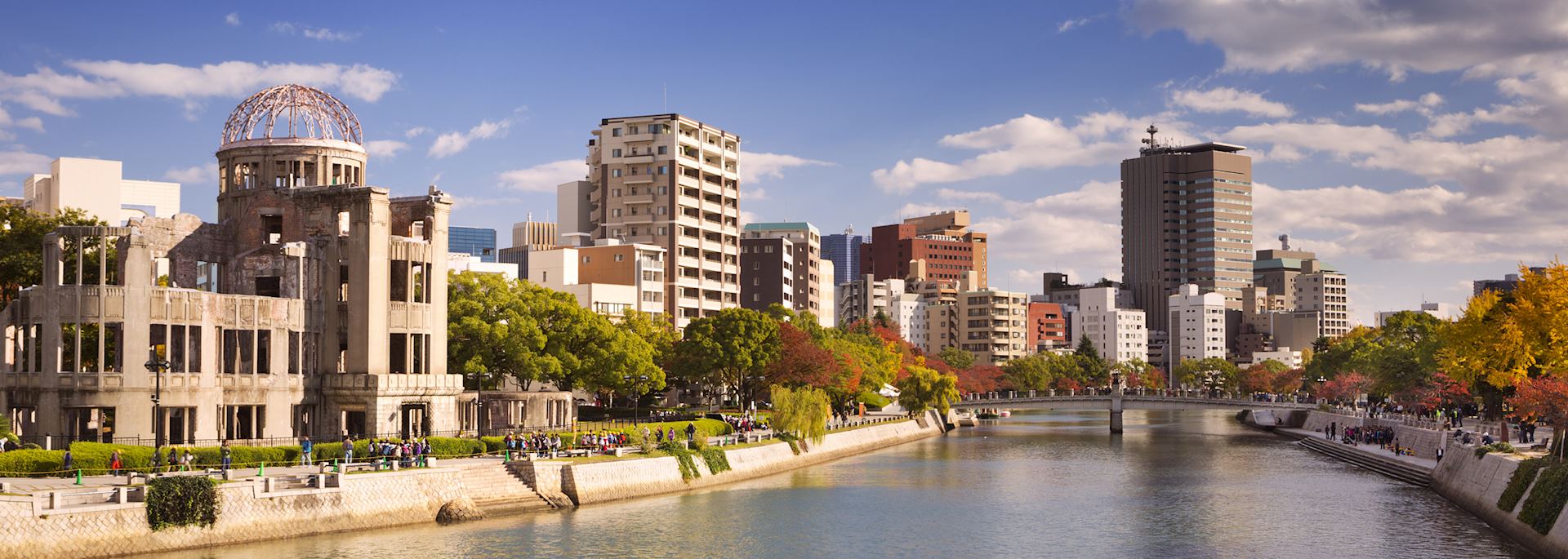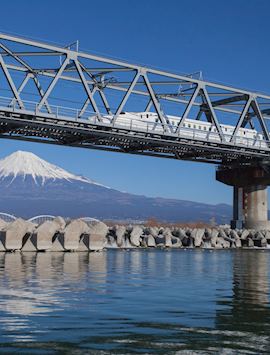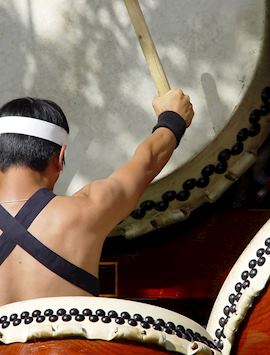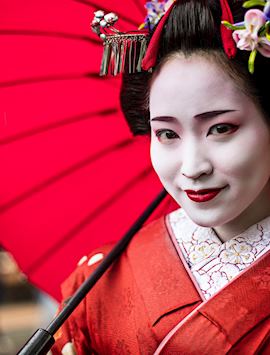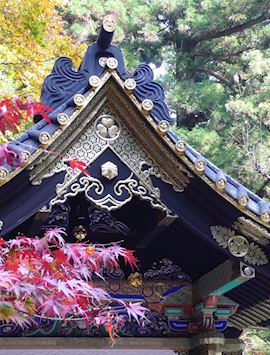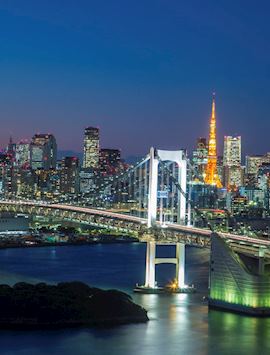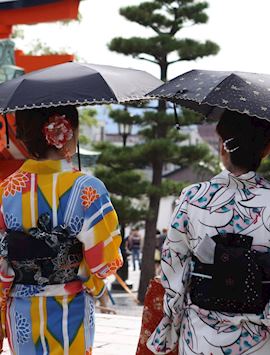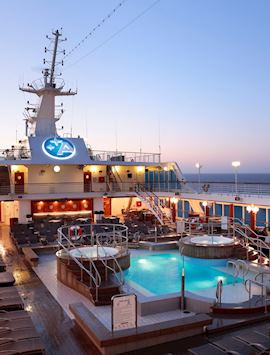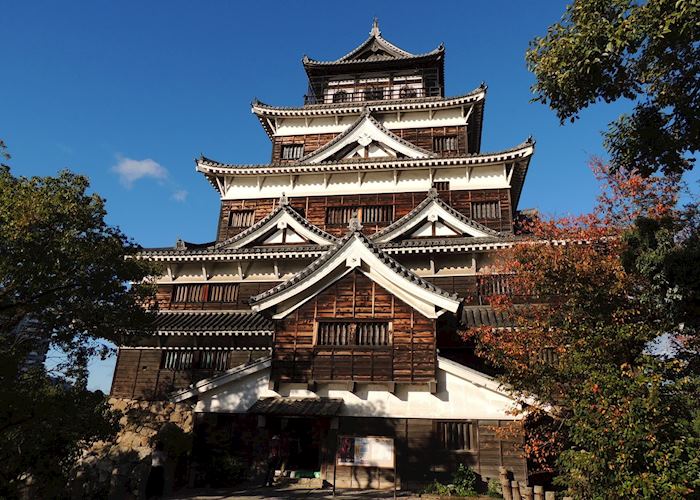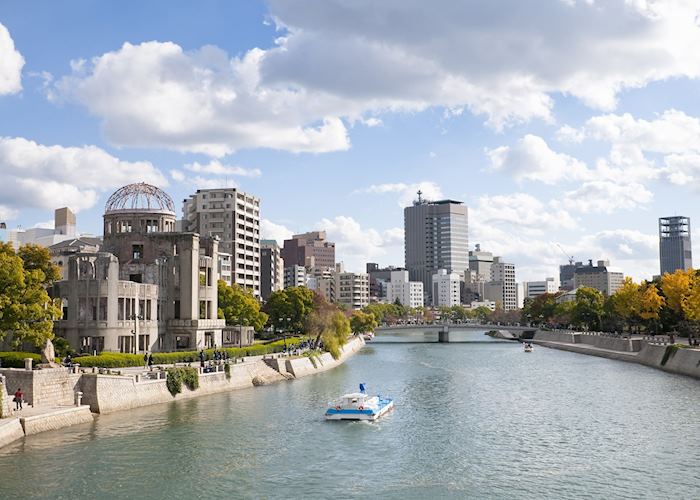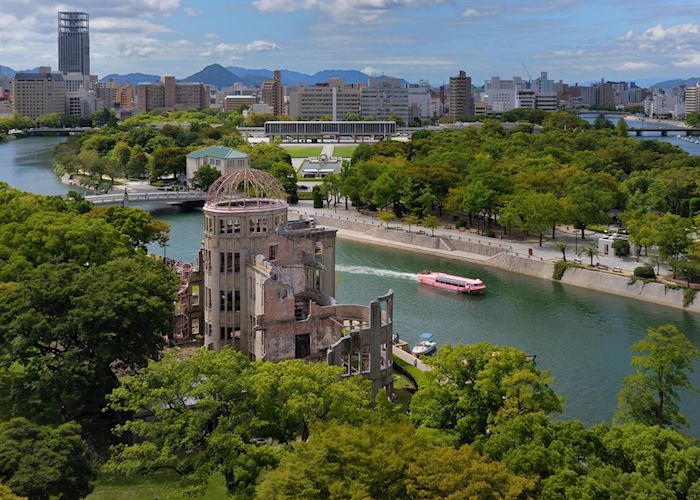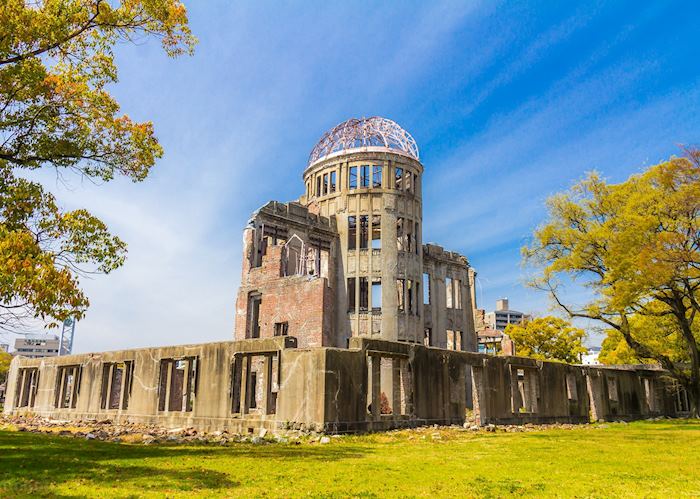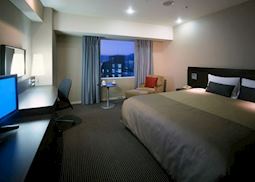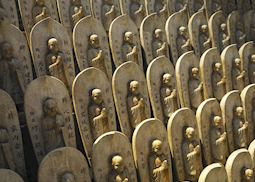Jump to:
The poignant Peace Park, wide tree-lined avenues, an eclectic tram network and the spiritual island of Miyajima dotted with temples and shrines await your visit to Hiroshima.
Beneath an arched cenotaph in Hiroshima’s Memorial Park a flame burns, waiting to be extinguished once the world is rid of nuclear weapons. Close by, thousands of paper cranes, a symbol of health and longevity, are spread in silent protest around the poignant Children’s Peace Memorial.
Hiroshima is a city that’s risen from the ashes and although the events of August 1945 are sensitively commemorated, the metropolis has an energetic and cosmopolitan feel. Situated a short boat ride away from the serene Miyajima Island, Hiroshima’s tree-lined avenues, eclectic tram network, exuberant baseball matches and the deeply moving Peace Park and Memorial Museum ensure there’s plenty for you to see and do.
Venture into Hiroshima’s past
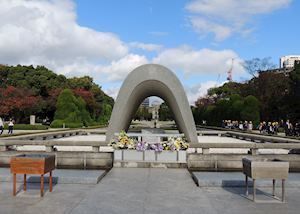 Embraced either side by the Honkawa and Motoyasu rivers, Hiroshima’s Peace Park lies in stark contrast to the busy commercial district that surrounds it. Everyday sounds recede as you enter the park — criss-crossing pathways meander, dotted with poignant memorials and quiet seated spaces inviting time to reflect.
Embraced either side by the Honkawa and Motoyasu rivers, Hiroshima’s Peace Park lies in stark contrast to the busy commercial district that surrounds it. Everyday sounds recede as you enter the park — criss-crossing pathways meander, dotted with poignant memorials and quiet seated spaces inviting time to reflect.
The middle of the park is dominated by the Peace Memorial Museum with the Memorial Cenotaph and the Flame of Peace lying beyond. Here, an open-ended saddle shaped monument containing the cenotaph appears to float on water. And, if you peer through the end closest to the museum you’ll view the Peace Flame and the torn remains of the Atomic Bomb Dome lying opposite within a frame.
Allow around two hours to visit the Peace Memorial Museum, which depicts the conditions at the time of the bombing through a variety of means — from eyewitness testimonies and evocative displays of personal effects to exhibits that depict Hiroshima before and after the bombing.
Hiroshima National Peace Memorial Hall
To the east of the cenotaph, the Hiroshima National Peace Memorial Hall is easy to miss because it’s largely subterranean but we recommend you look for the entrance. On entering, you’ll spiral down the softly lit walkways, eventually reaching the Hall of Remembrance which offers a 360-degree tiled panorama of the destruction, from the vantage of the bomb’s hypocentre. Small clusters of visitors fall silent slowly tracing their way around the hall.
Each tile represents a life taken, and an adjoining room lists the names and photographs of those who perished. The Peace Memorial Hall also holds a library containing memoirs, survivor testimony videos, photographs and film footage of Hiroshima before and after the bombing.
It’s also worth visiting the Children's Peace Monument where you can view paper cranes sent from around the world as a symbol of peace. And, on the other side of the Motoyasu river you can pay a visit to the haunting yet hopeful A-Bomb Dome — the former shell of Hiroshima’s Prefectural Industrial Hall, one of only a few buildings left standing after the bomb.
Take a ride on Hiroshima’s mobile museum
Not all of Hiroshima’s history is stationary — many of the trams that you see trundling around the city were donated from cities around Japan and around the world after the war, earning Hiroshima’s trams the nickname ‘The Moving Streetcar Museum’.
The streetcars vary from pre-war relics to the ultra-modern ‘Green Mover Max’ but all charge the same fare and stop close to the main sights. There’s a tram stop located at the south exit of Hiroshima’s railway station so hop onboard and you could find yourself riding a piece of Japanese transport history.
Taste Hiroshima’s ‘soul food’
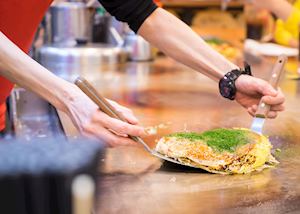 Just a few tram stops away from the Peace Park, keep an eye out for Okonomimura food village — a fairly inconspicuous mid-rise building, where hungry locals and visitors alike go in search of Hiroshima's signature dish, okonomiyaki — a savoury pancake packed full of vegetables, seafood, or meat. Over 20 steaming stalls offer different variations of this speciality so it’s very much a case of picking your perch, placing your order and watching the kitchen theatre next to you.
Just a few tram stops away from the Peace Park, keep an eye out for Okonomimura food village — a fairly inconspicuous mid-rise building, where hungry locals and visitors alike go in search of Hiroshima's signature dish, okonomiyaki — a savoury pancake packed full of vegetables, seafood, or meat. Over 20 steaming stalls offer different variations of this speciality so it’s very much a case of picking your perch, placing your order and watching the kitchen theatre next to you.
Pay a visit to the MAZDA Zoom-Zoom Stadium
A short walk away from Hiroshima Station lies the home of the much-loved Toyo Carp baseball team. During baseball season you’ll see joyful waves of red and white as fans make their way to a match — and it’s worth joining them. A knowledge of baseball is completely unnecessary — just enjoy the enthusiastic, rambunctious support of the fans, regardless of how their team plays.
Take a boat to Miyajima Island
A short boat ride away from the city lies Miyajima Island or Itsukushima as it was formerly known. Before heading into port you’ll see the vermillion torii that appears to rest on the water when the tide is in. Once you’ve disembarked, groups of sika deer will form a welcoming committee, their eager velvety noses on the hunt for snacks and treats, or failing that, travel maps.
From here, you can explore the village further, kayak in the waters under the torii, explore the buildings that comprise Itsukushima-jinja shrine and take the ropeway and hike to the top of Mount Misen, home to a collection of Buddhist sites and troupe of wild monkeys.
Best time to visit Hiroshima
The best times to visit Hiroshima tend to be from October to November and March through to May when temperatures are at their most comfortable and rain is minimal. Winter, from December through to February can be cold with the occasional snow shower, but it's a quieter time to go. The hot and humid climate can make travel uncomfortable from May to August.
who's been there
-
01993 838 92501993 838 210
- Make an enquiry
Suggested itineraries featuring Hiroshima
Our itineraries will give you suggestions for what is possible when you travel in Hiroshima, and they showcase routes we know work particularly well. Treat them as inspiration, because your trip will be created uniquely by one of our specialists.
Places near Hiroshima
- Miyajima Island 12 miles away
- Matsuyama 43 miles away
- Shikoku 77 miles away
- Kurashiki 77 miles away
- Matsue 83 miles away
- Naoshima 88 miles away
- Takamatsu 92 miles away
- Beppu 97 miles away
- Iya Valley 99 miles away
- Yufuin 100 miles away
- Kurokawa 119 miles away
- Tokushima 123 miles away
- Tottori 127 miles away
- Fukuoka 131 miles away
- Aso 132 miles away
- Kyushu 133 miles away
- Kumamoto 149 miles away
- Kinosaki Onsen 159 miles away
- Osaka 176 miles away
- Mount Koya 181 miles away
- Nagasaki 187 miles away
- Nara 192 miles away
- Kyoto 194 miles away
- Kirishima National Park 194 miles away
- Kagoshima 225 miles away
- Kanazawa 281 miles away
- Shirakawago 283 miles away
- Takayama 297 miles away
Photos of Hiroshima
Our expert guides to exploring Hiroshima
Written by our specialists from their own experiences of visiting Hiroshima, these guides will help you make the most of your time there. We share both our practical recommendations and the best ways to appreciate Hiroshima at its best.
-
Japan’s bullet trains: an all-you-need-to-know guide ![Bullet train passing by Mount Fuji]()
Japan’s bullet trains: an all-you-need-to-know guide
Japan’s bullet trains: an all-you-need-to-know guide
Japan has long been celebrated for its high-speed train innovations. Japan specialist Phil explains why, for him, Japan’s bullet trains are an ideal way to see the country. He shares his experiences riding the trains through Japan and how to incorporate them into your trip.
Read this guide
Accommodation choices for Hiroshima
We've selected a range of accommodation options for when you visit Hiroshima. Our choices usually come recommended for their character, facilities and service or location. Our specialists always aim to suggest properties that match your preferences.
-
![Double room, ANA Crowne Plaza]()
ANA Crowne Plaza Hotel
Hiroshima -
![Deluxe room, Sheraton Hiroshima]()
Sheraton Hiroshima
Hiroshima
Ideas for experiencing Hiroshima
Our specialists seek out authentic ways to get to know the places that could feature in your trip. These activities reflect some of the experiences they've most enjoyed while visiting Hiroshima, and which use the best local guides.
-
Miyajima Island excursion ![Buddhist statues, Miyajima]()
Miyajima Island excursion
Miyajima Island excursion
Begin your sightseeing with a visit to the shoreline to see the torii gate at its most photogenic — when the tide is high, but also interesting when the waters have receded and you can walk up to the huge structure and admire it close up.
View details

